Minakari | Persian Enamel
One of Iran's most distinctive and exquisite forms of handicraft is Minakari, which calls for patience, accuracy, and time in addition to the artist's aesthetic sense and taste.
Like other handicrafts, Meenakari has undergone significant changes throughout Iran's history. These developments owe to the creativity and skill of talented Iranian artisans. The application of this art is now more accessible, thanks to the development of industrial machines.
Iranian Minakari, The Art of Coloring Metal
One should first look at how these works are done and the required materials, then consider the critical indicators for spotting high-quality and original Minakari to get more familiar with this unique art-craft.
If you're interested in learning more about this incredible Iranian handcraft, this post is for you.
| Find related articles here: Persian Art
What is Minakari art?
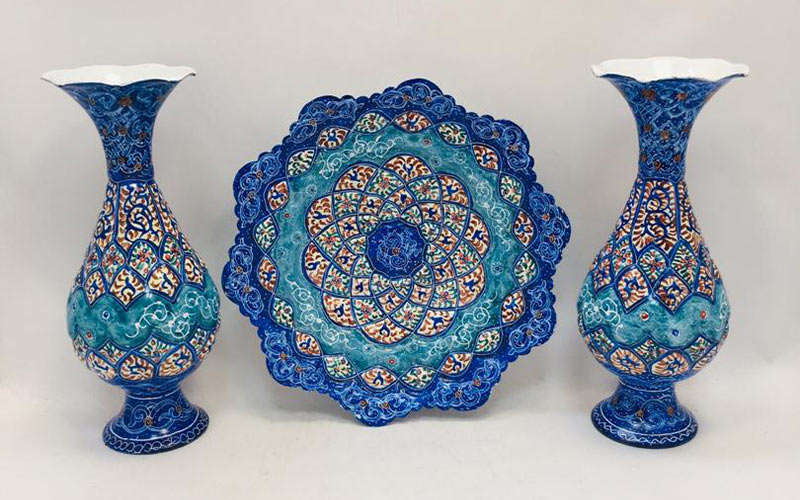
Minakari or Meenakari (Enamelling) is one of Iran's most beautiful and delicate handicraft arts. It is the process of painting and decorating the surface of metals such as gold, silver, and copper using glaze colors and fire in a furnace. Sometimes Mina Kari is used to decorating glass or ceramics. Minakari is accomplished by using dazzling colors, mostly azure and Persian blue, in stunning designs, shapes, and natural themes of birds and flowers.
Minakari Meaning
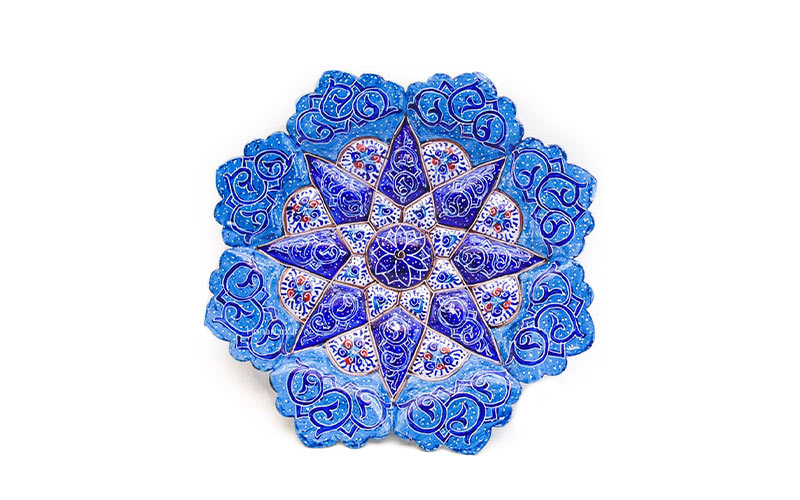
In the Persian language, Mina refers to a water bottle (Abgineh), wine glass, bowl, or blue glaze with which painted silver and gold are covered.
The concept is derived from Mina or Meena, the Persian word 'Minoo.' It means heaven or paradise, and 'Kari' means 'doing' or 'putting something onto something else.' Accordingly, the word 'Minakari' means placing heaven onto an object.
Minakari, an old and intricate art form, is regarded as one of the most elaborate and complex metal embellishments, requiring devotion, passion, expertise, and accuracy.
History of Minakari
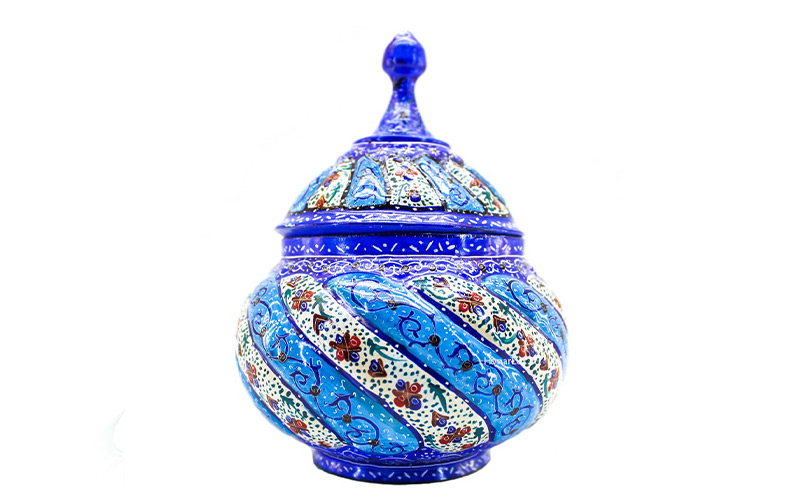
Around the 6th century BC, the Greeks got to know enamel work. Using this method, they decorated ornaments made by tapestry with fragile gold and silver wires with an enamel glaze. But today, what we recognize as Minakari is rooted in Iranian culture and tradition. Today, Isfahan City is known as the center of Minakari in Iran. It is said that the art of Minakari, the art of combining fire, clay and painting, dated back five thousand years ago. If we follow the traces of Minakari in history, we will find the following evidence:
- Some experts, comparing Byzantine enamels with Persian Minakari, have concluded that Minakari were first formed in Iran and then spread to other countries.
- The early examples of Minakari art can be seen in the works obtained from Hasanlu excavations in Azerbaijan in the form of six glass necklace beads related to the years 900-800 BC. Among other works, we can mention a golden cross from the "Ziviyeh" treasure of Kurdistan, decorated with glass-colored paste. On the beads, the pattern of eyes can be seen in pea, pale blue, garlic blue, and brown colors.
- Among the other existing documents is an old armband from the Achaemenid period, decorated with enamel. Now, this ancient work is kept in the Albert Museum in London.
- The art of enameling in Europe also has a long history. The ring found in Cyprus, which had enamel motifs, dates back to the thirteenth century BC.
- In the Sassanid period, plates with enamel designs were discovered in Armenia. These artworks are kept in the Metropolitan Museum of New York and are examples of the ancient works of Persian Minakari art.
- This art reached its peak in the Seljuk period, and the design of brass and enamelware became popular and spread to other countries.
- One of the remaining precious works is "Alb-Arsalan Tray," done by a master named "Hassan Al Kashani," which is kept in the Boston Museum of Fine Arts.
- During the Mongol era, a new style of enamel art was created using chemistry. The enamellers of this period made innovations in the design field, and the images with the faces and clothes of Iranians replaced Arabic images. This method reached its peak in the metal inlaying of the Timur period, examples of which can be seen on the doors and chandeliers of the Timur palace.
- This art was unknown and unfamiliar to India but was later introduced by the Mughals.
- During the Safavid era, enameling was done on silver. Their designs were deer, hunting, and horse riding. After a while, Slimi and Khatai designs were added to the designs, and the enamelers mostly used red.
- Qajar era Minaakari was primarily used in gold. The very fine Meenakari of this era, among the first Persian Minakari with a signature, was used to make shrines and tablets for installation in religious places.
After the fall of the Qajar, the prosperity and popularity of this art gradually decreased until, at the beginning of Reza Shah's reign, a German named "Martin" established an institution in the city of Isfahan. With the help of artists with Iranian taste, he made Minakari on silver with Khatay and Slimi motifs. Once again, enamel art regained its prestige and importance and returned to its golden age.
The Process of Minakari
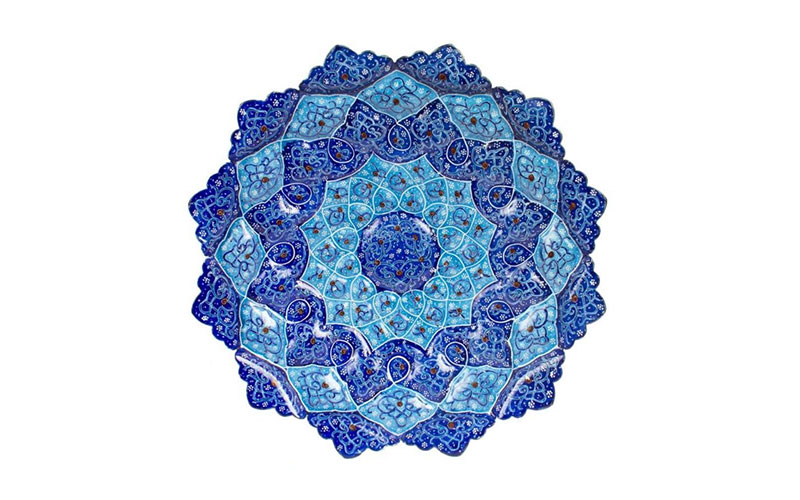
Meenakari involves the use of gold, silver, and copper sheets. Because of its increased malleability and non-oxidization at the enamel melting point, gold foil outperforms other metals. But, due to the high cost of gold and silver, copper sheets are now more commonly used for enamel. Copper metal absorbs glaze more readily than other metals. It should be 99% pure and thick. Suppose the copper sheets are of poor quality. In that case, impurities will appear on the surface of the work during heating, lowering the value of the work significantly.
Persian Minakari steps are as follows:
Shaping the base: It is the most fundamental and vital stage of the enamel work. It is done two ways after selecting the metal: hammering and bending. The hammering procedure involves the artisan striking the metallic substrate repeatedly with the hammer. The bending method shapes the metal sheet with a machine to make various objects. After that, the object's surface is polished, and the appendages are removed.
1. Glaze work:
The object is coated in the glaze by spraying or dipping so that the entire surface is completely covered.
2. Glaze firing:
After drying and removing impurities from the glaze, the firing process is carried out in the furnace at 700 °C for 2 to 3 minutes. After that, the object is again covered with a high-quality glaze and placed in the furnace at a lower temperature.
3. Painting:
After cooling down, the artist uses a brush method known as Ghalamgiri to paint the surface creatively. After that, the object is heated at 400 °C or 600 °C to bring out the final colors.
Types of Minakari Colors
Enameling paints are fireproof and mainly composed of metal oxide powder. In the past, natural and mineral colors were used; however, metal and chemical colors are now becoming more popular:
White: Usually, white is not used in enameling, and the artist can use the white color of the background to create white lines and designs based on his skills.
Yellow: The combination of iron filings, chromium oxide, tin oxide, and lead.
Purple: The combination of the gold solution, ammonium chloride, or glass shards.
Black: The combination of manganese dioxide, lead, iron oxide, and cobalt.
Green: The combination of lead chromate, copper shavings, and flint.
Brown: The combination of zinc oxide, green chrome, and iron oxide.
Blue: The combination of cobalt oxide, flint, and zinc oxide.
Golden: Gold plate is used.
Types of Minakari Tools
Among the essential enameling tools, we can mention metal sheets (gold, silver, copper, iron, and brass), copy paper, metal saw, bow saw, brush, cutting scissors, clamps, furnaces, hammer, and various types of colors.
How To Recognize Authentic Minakari
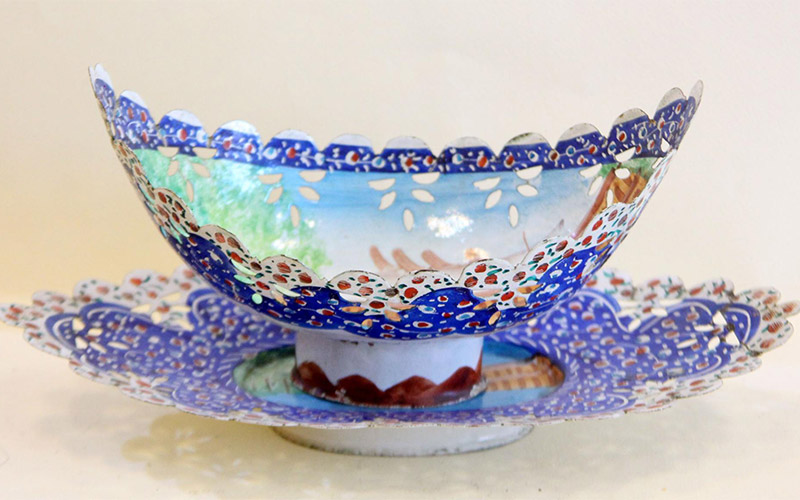
If you want to buy high-quality Minakari artwork, it is better to keep the following tips in mind:
- It must be shiny, polished, and have glossiness. Avoid buying works that have sharp edges, cuts, bubbles and cracks.
- The infrastructure must be of high quality and pure metal.
- In works with more than one infrastructure, ensuring that the soldered parts are not visible.
- The thickness of the paint used in painting and decorations should be even on all work surfaces.
- The surface of the glaze should not have roughness, bumps, cracks, and discoloration.
- It is better to buy enamel that works with a certificate and is signed by the artist.
- If the copper used in the infrastructure has a small weight compared to the size of the container, the price is lower.
- Colors in quality work should not interfere with each other.
Minakari Handicrafts and Artworks
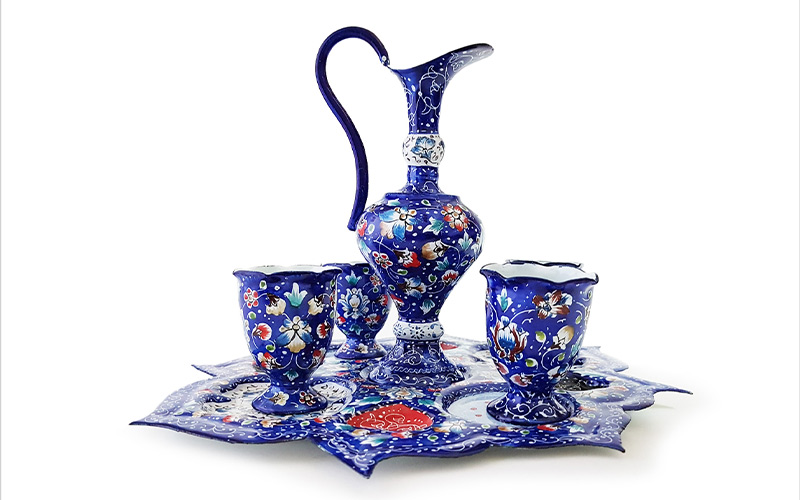
Nowadays, the combination of enamel art with gilding (Tala Kari), inlaying (Khatam Kari), and miniature painting is used in making and decorating a variety of products such as:
- Minakari Plates, vases, bowls, and photo frames
- Meenakari jewelry, Meenakari earrings, Meenakari necklaces, rings, and chest pins.
- Minakari gift box, Quran box, Photo album covers, mirrors, tea serving sets, and hookah body.
- The art of Minakari paintings, themes, and patterns are used in designing clothes such as Minakari dresses, belts, scarves, and hats.
The Most Famous Minakari Artists In Iran
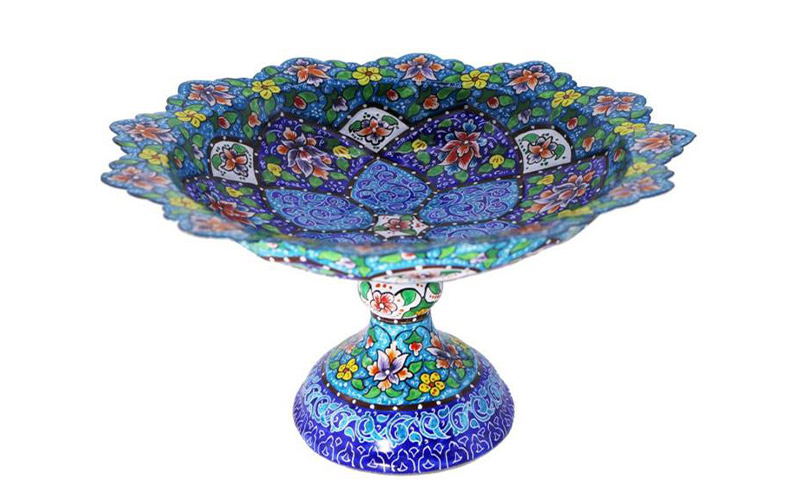
The artist who practices Minakari is called 'Minakar.' Among Iranian Minakars, the most famous artist are:
- Gholamhossein Faizollahi
- Ebrahim Zarkouni
- Hossein Hanrdost
- Mina Johari (one of the contemporary Minakari artists)
- Nematullahi brothers
- Mohammad Ali Farshid
- Mehdi Ghaffarian
- Shukrallah Sanizadeh
Types of Minakari
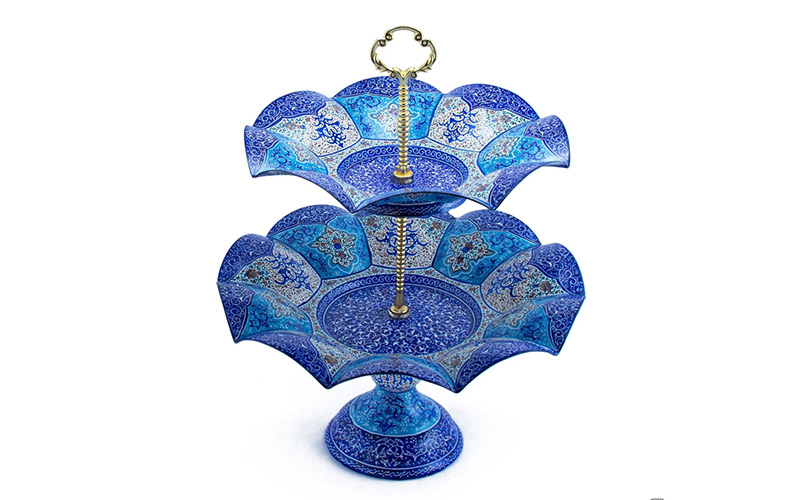
Nowadays, Minakari is done in two common ways; painted Minakari and wire-inlaid. The first method is done as the base is shaped and coated in white glaze. After heating it at 700°C and cooling it down, the artist designed and painted the object's surface. Then again, the object is heated at 400°C for the last time.
In the second method, fragile wires are used. The wires are attached to the body of the main object based on the design, covered by glaze, and heated in the furnace. The wires get attached to the body and become part of the object. In the next step, the desired colors are sprinkled on the surface.
Bottom line
Minakari art is a beautiful and enjoyable slice of life that brings people closer together to nature than ever. The artist makes stunning and captivating pieces inspired by emotions, taste, and nature. Due to its distinctive and unique qualities, it is evident that each art effectively demonstrates the existence and identity of a nation's culture.
Visit Isfahan and bring some art back with you. You seem to be holding the entire world in your hands.


Comment
Leave a Comment